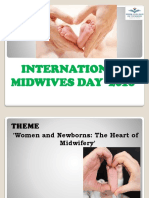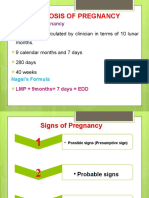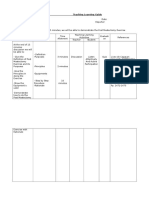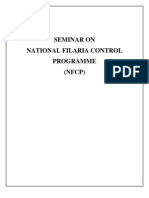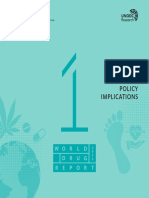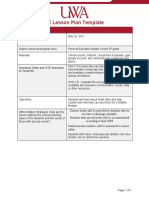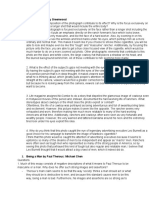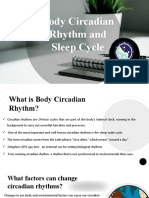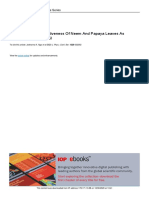Professional Documents
Culture Documents
Knowledge Regarding Menstrual Cup Among Nursing Students
Copyright
Available Formats
Share this document
Did you find this document useful?
Is this content inappropriate?
Report this DocumentCopyright:
Available Formats
Knowledge Regarding Menstrual Cup Among Nursing Students
Copyright:
Available Formats
Volume 7, Issue 10, October – 2022 International Journal of Innovative Science and Research Technology
ISSN No:-2456-2165
Knowledge Regarding Menstrual
Cup among Nursing Students
Priya Mary Stella
Nehru College of Nursing
Abstract:- A descriptive study was conducted to assess the Enter the menstrual cup. I bought two cups at a
knowledge regarding menstrual cup among student discounted price of ₹500 (for both). One cup is supposed to
nurses in a selected college, kannur. A non experimental last for five years. That works out to be about ₹8 a period.
descriptive design was used in the study. The sample Several brands have entered the space, and a cup is priced
consisted of 40 nursing students from a selected college of anywhere between ₹500 and ₹1,000. Not to forget the huge
nursing. environmental benefit to using the cup: One sanitary napkin
can take around 500-800 years to decompose. Data from
Data was collected by using the self administered Ministry of Drinking Water and Sanitation shows that 28 per
questionnaire which comprised of 30 questions. Data was cent of pads are thrown in mixed waste and end in the landfill,
analyzed by using descriptive and inferential statistics. 28 per cent are thrown in the open, while 33 per cent are
The association between knowledge score and selected disposed via burial and 15 per cent are burnt, even though the
demographic variables was analyzed by chi square test. Solid Waste Management Rules 2016 clearly state that waste
segregation has to be practiced at source. The rules also
The study findings revealed the knowledge level mandate that waste generators need to work with local
regarding menstrual cup, 3(7.5%) of student nurses had administration and set up waste management systems for
excellent knowledge, 19(47.5%) of student nurses had sanitary waste. Packaging waste also needs to be accounted
adequate knowledge, 16(40%) of student nurses had for by the companies.
moderately adequate knowledge and 2(5%) of student
nurses had inadequate knowledge, Since very few student The truth on ground couldn’t be further from this reality.
nurses had excellent knowledge regarding menstrual cups Sanitary napkins and tampons also hold a risk of toxic shock
slides on menstrual cup was shared to the participants to syndrome, a rare but serious medical condition brought on by
enhance their knowledge regarding menstrual cup. bacteria.
Keywords:- Knowledge, Menstrual Cup, Student Nurses. As already discussed above menstrual cup is being eco
friendly, it is also cost effective, with a lifetime up to 10 years
I. INTRODUCTION without any health hazards and less chance of vaginal
irrigation and infection.. Extremely travel friendly and no
Menstrual hygiene has a long, twisted history in India. need to be changed often. Also does not emit odor.
Access to menstrual hygiene is related to gender equality in a
crucial way; lack of bathrooms or sanitary napkins is one of It is important to know what extent health care practices
the primary reasons why girls drop out of school. Whenever has been improved. There is a need for health care providers
disaster hits, along with calls for food supplies and clothes, and educators to provide awareness on menstrual cups to girls
there is a demand for sanitary napkins. Yet, we were taxed (at and women. It is with this background, need and significance
18 per cent GST) for our autonomy by the government until that a study was conducted to assess knowledge regarding
years of campaigning resulted in some relief in GST menstrual cup among student nurses.
compensation.
Problem Statement
India has the lowest penetration of sanitary napkins in A study to assess the knowledge regarding menstrual
the world. Reports by top business players in this segment (P cup among student nurses in a selected college, kannur
& G, Johnson and Johnson) peg the penetration of sanitary
napkins in India at 15-20 per cent of the population, though Objectives of the Study
the government’s National Family Household Survey claims Assess knowledge level regarding menstrual cup among
higher penetration (national average of about 48 per cent in student nurses
rural, 58 per cent in urban areas). Prices of products are still Find out the association between the knowledge level
high: An average 5-7 day period costs an average of ₹88, a regarding menstrual cup among student nurses and their
significant chunk of the daily minimum average wage rate at selected demographic variables.
₹180.
IJISRT22OCT218 www.ijisrt.com 1607
Volume 7, Issue 10, October – 2022 International Journal of Innovative Science and Research Technology
ISSN No:-2456-2165
Hypothesis REFERENCES
H1-There will be a significant association between
knowledge level regarding menstrual cup among Student [1]. Guidelines for management of sanitary waste. Available
nurses and their selected demographic variables. at: https://kspcb.gov.in › Sanitary Waste_. Accessed on
06th August 2019.
II. REVIEW OF LITERATURE [2]. The mammoth task of managing menstrual waste in
India. Available at: https://www.downtoearth.org.in ›
The review of literature was organized and categorized blog › health › the-mammoth-task-of-m. Accessed on
based on studies related to menstrual cup 27th February 2019.
[3]. Kaur R, Kaur K, Kaur R. Menstrual hygiene,
III. METHODOLOGY management, and waste disposal: practices and
challenges faced by girls/women of developing
A non experimental descriptive design was adopted in countries. J Envir Pub Health. 2018;2018. 4. Juma J,
the study. The sample consisted of 40 nursing students from Nyothach E, Laserson KF, Oduor C, Arita L, Ouma C,
Canossa College of Nursing, Cherukunnu. et al. Examining the safety of menstrual cups among
rural primary school girls in western Kenya:
Data was collected by using the self administered observational studies nested in a randomised controlled
questionnaire which comprised of 30 questions. Data was feasibility study. BMJ Open. 2017; 7(4):e015429.
analyzed by using descriptive and inferential statistics. The [4]. Mitchell MA, Bisch S, Arntfield S, Hosseini-
association between knowledge score and selected Moghaddam SM. A confirmed case of toxic shock
demographic variables was analyzed by chi square test. syndrome associated with the use of a menstrual cup.
Canad J Infect Dis Med Microbiol. 2015 ;26(4):218-20.
IV. FINDINGS
E-Sources
The study findings revealed that the knowledge level [5]. research-methodology.net
regarding menstrual cup, 3(7.5%) of student nurses had [6]. Menstrual_cup_awareness_among_reproductive_wom
excellent knowledge, 19(47.5%) of student nurses had en.pdf
adequate knowledge, 16(40%) of student nurses had [7]. Mirit-sheila-Makena-pdf
moderately adequate knowledge and 2(5%) of student nurses [8]. Raksha_suvarna_FINAL.pdf
had inadequate knowledge, Since very few student nurses had [9]. Study
excellent knowledge regarding menstrual cups slides on of_adaptability_and_efficacy_of_Menstrual_cu(1).pdf
menstrual cup was shared to the participants to enhance their [10]. VanEijKMenstrualcuplancet2019(1).pdf
knowledge regarding menstrual cup. [11]. https://en.m.wikipedia.org/wiki/Research
[12]. https://www.webmd.com/women/news/20190717/men
The study findings revealed that the calculated chi- strual-cup-equal-pads-tampons-
square value of all demographic variables like age, year of [13]. https://bmjopen.bmj.com/content/7/4/e015429
course ,type of family, area of residence, educational status [14]. https://www.thelancet.com/journals/lanpub/article/PIIS
of mother, occupation of mother ,age at menarche, currently 2468-2667(19)30111-2/Fulltext
used sanitary protection, prior information regarding [15]. https://reproductive-health-
menstrual cup and source of information are all less than the journal.biomedcentral.com/articles/10-1186/s12978-
table value at 0.05 level hence, there is no association 020-
between knowledge level regarding menstrual cup among [16]. https://reproductive-health-
Student nurses and their selected demographic variables. journal.boimedcentral.com/articles/10.1186/s12978-
Hence the formulated research hypothesis H1 is rejected and 018-
the null hypothesis is accepted. [17]. https://bmjopen.bmj.com/content/7/4/e01529
[18]. https://reproductive-health-
V. CONCLUSION journal.biomedcentral.com/articles/10.1186s12978-
020-
Menstrual cups can be the key to liberation and access [19]. https://www.healthline.com
to all sorts of wonderful things — education and a livelihood
for instance — by freeing women in developing countries Books
from being confined to their homes during their period. The [20]. Denise E Polit and Cheryl Tatano Beck; Nursing
municipality of Alappuzha in Kerala was the first civic body Research, principals and methods, 7thedition;
in India to distribute 5,000 menstrual cups for free, in an eco- pageno;109-111,157-158
friendly sanitation drive in 2019. Women’s liberation? Hell [21]. Dr. T. Vasundara Tulasi; Nursing research and
yes! One can tell that a woman invented the menstrual cup. statistics:; 1stedition; Books ea publications;
pageno;147-150&354-355
In spite of the limitations of this study, this study shows
that the menstrual cup can replace the other methods of
menstrual sanitation. Increasing awareness in young girls can
help to increase the utilization of menstrual cups.
IJISRT22OCT218 www.ijisrt.com 1608
You might also like
- Breastfeeding BibliographyDocument6 pagesBreastfeeding BibliographyPiyush DuttaNo ratings yet
- Research Proposal WRDDocument38 pagesResearch Proposal WRDEsha KuttiNo ratings yet
- Elderly Primigravida, Adolescent Pregnancy, Grand MultiparaDocument3 pagesElderly Primigravida, Adolescent Pregnancy, Grand MultiparamercyNo ratings yet
- Postnatal ExaminationDocument19 pagesPostnatal ExaminationAlpha100% (1)
- Drugs Used IN Pregnancy, Labour, Puerperium & NewbornDocument42 pagesDrugs Used IN Pregnancy, Labour, Puerperium & NewbornSanjay Kumar SanjuNo ratings yet
- Kangaroo Mother CareDocument9 pagesKangaroo Mother CareSREEDEVI T SURESHNo ratings yet
- KMC Benefits Babies Through Skin-to-Skin ContactDocument24 pagesKMC Benefits Babies Through Skin-to-Skin ContactBrijesh Yadav100% (1)
- REGISTRATION FORM TITLEDocument2 pagesREGISTRATION FORM TITLEGaurav Kharb50% (2)
- International Midwives DayDocument48 pagesInternational Midwives Daymikegrace02No ratings yet
- Drug Study ON Cabergolin EDocument4 pagesDrug Study ON Cabergolin ESimran SimzNo ratings yet
- The Evil of Female Foeticide in IndiaDocument12 pagesThe Evil of Female Foeticide in IndiaMr. Nik OPNo ratings yet
- Thromboembolic DisordersDocument11 pagesThromboembolic Disordersannu panchalNo ratings yet
- Pregnancy Diagnosis StagesDocument25 pagesPregnancy Diagnosis StagesA suhasiniNo ratings yet
- Fluid Electrolyte ImbalanceDocument46 pagesFluid Electrolyte ImbalanceAxsa AlexNo ratings yet
- A Study To Assess The Knowledge of Primi Gravida Mother Regarding Importance Colostrum at Selected Hospital Bagalkot Karnataka, IndiaDocument10 pagesA Study To Assess The Knowledge of Primi Gravida Mother Regarding Importance Colostrum at Selected Hospital Bagalkot Karnataka, IndiaInternational Journal of Innovative Science and Research TechnologyNo ratings yet
- Monitoring Labor Progress with the PartographDocument6 pagesMonitoring Labor Progress with the Partographalyssa marie salcedo100% (1)
- 5 EPISIOTOMY N SUTURING Case - Book Rupi - OBS p346-366Document21 pages5 EPISIOTOMY N SUTURING Case - Book Rupi - OBS p346-366piyush0751No ratings yet
- Lesson PlanDocument4 pagesLesson PlanMonika Joseph50% (4)
- Psychosocial and Cultural Aspects InpregnancyDocument2 pagesPsychosocial and Cultural Aspects InpregnancyKavitha p0% (1)
- Cervical DystociaDocument22 pagesCervical DystociaBaldau TiwariNo ratings yet
- Cu-T IUCD Insertion RecordsDocument6 pagesCu-T IUCD Insertion RecordsKaku ManishaNo ratings yet
- Breast Care Means Care Given To The Breast by The Mother During Her Prenatal Period, Intranatal Period and Postnatal PeriodDocument6 pagesBreast Care Means Care Given To The Breast by The Mother During Her Prenatal Period, Intranatal Period and Postnatal PeriodCagabcab Canibel MelanyNo ratings yet
- 2 Substitutes For Non-Vegetarian FoodsDocument30 pages2 Substitutes For Non-Vegetarian FoodsChinju Cyril100% (1)
- Health Talk TopicsDocument3 pagesHealth Talk TopicsNisma ShresthaNo ratings yet
- Vancouver and Apa StyleDocument8 pagesVancouver and Apa StylePankaj Khatri100% (1)
- Lesson Plan On Antenatal EXERCISESDocument43 pagesLesson Plan On Antenatal EXERCISESswatiNo ratings yet
- Topic Prensentation ON: Kangaroo Mother CareDocument15 pagesTopic Prensentation ON: Kangaroo Mother Careamit100% (1)
- Antenatal Diet and Exercise GuideDocument14 pagesAntenatal Diet and Exercise GuideKinjal VasavaNo ratings yet
- Skill 11 (1) ..Collection of Stool SpecimenDocument1 pageSkill 11 (1) ..Collection of Stool SpecimennetsquadNo ratings yet
- Era University / Era College of Nursing: Lesson Plan On-Abnormal Uterine BleedingDocument14 pagesEra University / Era College of Nursing: Lesson Plan On-Abnormal Uterine BleedingShreya Sinha100% (2)
- Development of COMMUNITY HEALTH NURSING in IndiaDocument12 pagesDevelopment of COMMUNITY HEALTH NURSING in IndiaKapil Verma100% (3)
- Thermometer TechniqueDocument6 pagesThermometer TechniqueJulianne B. Dela CruzNo ratings yet
- Health Care Delivery Sysytem in India-2020Document40 pagesHealth Care Delivery Sysytem in India-2020Sree LathaNo ratings yet
- Lesson Plan On Postnatal AssessmentDocument11 pagesLesson Plan On Postnatal AssessmentMadhavi ModaNo ratings yet
- Government College of Nursing Jodhpur (Raj.) : Procedure On-Cordiotocography Subject-Obstetrics & Gynecology Specialty-IDocument6 pagesGovernment College of Nursing Jodhpur (Raj.) : Procedure On-Cordiotocography Subject-Obstetrics & Gynecology Specialty-Ipriyanka100% (1)
- Health Education On HypertentionDocument13 pagesHealth Education On HypertentionParth VasaveNo ratings yet
- Small Family NormDocument10 pagesSmall Family NormPriya Sharma100% (5)
- Postnatal Care: Preventing Maternal DeathDocument26 pagesPostnatal Care: Preventing Maternal DeathShivani Shah100% (1)
- Historical and Contemporary Perspectives, Issues of Maternal and Child HealthDocument96 pagesHistorical and Contemporary Perspectives, Issues of Maternal and Child HealthBindu Philip100% (1)
- Health Talk On MenopauseDocument19 pagesHealth Talk On Menopausepriyanka100% (1)
- Labor Augmentation Drugs SheetDocument34 pagesLabor Augmentation Drugs SheetpriyankaNo ratings yet
- Trends in Midwifery and Obstetrical NursingDocument27 pagesTrends in Midwifery and Obstetrical NursingVinayak Srivastava100% (1)
- Post Mastectomy ExerciseDocument4 pagesPost Mastectomy ExerciseKusum RoyNo ratings yet
- Diagnostic Modalities in PregnancyDocument11 pagesDiagnostic Modalities in PregnancyRavina Patel100% (1)
- Sandeep Kaur ResumeDocument2 pagesSandeep Kaur Resumeapi-4635861210% (2)
- SUPPLEMENTED BREASTFEEDING and COMPLEMENTARY FEEDINGDocument45 pagesSUPPLEMENTED BREASTFEEDING and COMPLEMENTARY FEEDINGPriyanjali SainiNo ratings yet
- Integrated Child Development Services PresentationDocument33 pagesIntegrated Child Development Services PresentationNamitha Elizabeth Mani100% (1)
- Filaria - Final 4Document14 pagesFilaria - Final 4Arun Jv100% (1)
- Maintaining High Staff Morale Through Engagement, Training and RecognitionDocument14 pagesMaintaining High Staff Morale Through Engagement, Training and RecognitionAparna KinginiNo ratings yet
- Epidemiological SEMINOR 1 FINALDocument22 pagesEpidemiological SEMINOR 1 FINALRatna Vimal100% (1)
- Permanent Family PlanningDocument36 pagesPermanent Family PlanningNilakshi Barik MandalNo ratings yet
- 4-Drugs in Obs & GyneDocument52 pages4-Drugs in Obs & Gyneapi-37033520% (2)
- Demonstration On EpisiotomyDocument11 pagesDemonstration On EpisiotomyBabita DhruwNo ratings yet
- Postpartum Hemorrhage (PPH) ManagementDocument38 pagesPostpartum Hemorrhage (PPH) ManagementPrakash ThakullaNo ratings yet
- Antenatal Preparation OBG - FOR BSC NURSING STUDENTSDocument22 pagesAntenatal Preparation OBG - FOR BSC NURSING STUDENTSKripa Susan100% (1)
- Antenatal Assessment ProcedureDocument3 pagesAntenatal Assessment ProcedureSANCHAYEETANo ratings yet
- STAGES OF LABOURDocument37 pagesSTAGES OF LABOURJude Martin100% (1)
- Journal Homepage: - : IntroductionDocument5 pagesJournal Homepage: - : IntroductionIJAR JOURNALNo ratings yet
- Snehas International JournalDocument13 pagesSnehas International Journalsnehabhaval913No ratings yet
- The Study About The Awareness of Menstrual Cup Among Female Social Work Students in Christ College Autonomous Irinjalakuda, KeralaDocument5 pagesThe Study About The Awareness of Menstrual Cup Among Female Social Work Students in Christ College Autonomous Irinjalakuda, KeralaEditor IJTSRDNo ratings yet
- An Analysis on Mental Health Issues among IndividualsDocument6 pagesAn Analysis on Mental Health Issues among IndividualsInternational Journal of Innovative Science and Research TechnologyNo ratings yet
- Harnessing Open Innovation for Translating Global Languages into Indian LanuagesDocument7 pagesHarnessing Open Innovation for Translating Global Languages into Indian LanuagesInternational Journal of Innovative Science and Research TechnologyNo ratings yet
- Diabetic Retinopathy Stage Detection Using CNN and Inception V3Document9 pagesDiabetic Retinopathy Stage Detection Using CNN and Inception V3International Journal of Innovative Science and Research TechnologyNo ratings yet
- Investigating Factors Influencing Employee Absenteeism: A Case Study of Secondary Schools in MuscatDocument16 pagesInvestigating Factors Influencing Employee Absenteeism: A Case Study of Secondary Schools in MuscatInternational Journal of Innovative Science and Research TechnologyNo ratings yet
- Exploring the Molecular Docking Interactions between the Polyherbal Formulation Ibadhychooranam and Human Aldose Reductase Enzyme as a Novel Approach for Investigating its Potential Efficacy in Management of CataractDocument7 pagesExploring the Molecular Docking Interactions between the Polyherbal Formulation Ibadhychooranam and Human Aldose Reductase Enzyme as a Novel Approach for Investigating its Potential Efficacy in Management of CataractInternational Journal of Innovative Science and Research TechnologyNo ratings yet
- The Making of Object Recognition Eyeglasses for the Visually Impaired using Image AIDocument6 pagesThe Making of Object Recognition Eyeglasses for the Visually Impaired using Image AIInternational Journal of Innovative Science and Research TechnologyNo ratings yet
- The Relationship between Teacher Reflective Practice and Students Engagement in the Public Elementary SchoolDocument31 pagesThe Relationship between Teacher Reflective Practice and Students Engagement in the Public Elementary SchoolInternational Journal of Innovative Science and Research TechnologyNo ratings yet
- Dense Wavelength Division Multiplexing (DWDM) in IT Networks: A Leap Beyond Synchronous Digital Hierarchy (SDH)Document2 pagesDense Wavelength Division Multiplexing (DWDM) in IT Networks: A Leap Beyond Synchronous Digital Hierarchy (SDH)International Journal of Innovative Science and Research TechnologyNo ratings yet
- Comparatively Design and Analyze Elevated Rectangular Water Reservoir with and without Bracing for Different Stagging HeightDocument4 pagesComparatively Design and Analyze Elevated Rectangular Water Reservoir with and without Bracing for Different Stagging HeightInternational Journal of Innovative Science and Research TechnologyNo ratings yet
- The Impact of Digital Marketing Dimensions on Customer SatisfactionDocument6 pagesThe Impact of Digital Marketing Dimensions on Customer SatisfactionInternational Journal of Innovative Science and Research TechnologyNo ratings yet
- Electro-Optics Properties of Intact Cocoa Beans based on Near Infrared TechnologyDocument7 pagesElectro-Optics Properties of Intact Cocoa Beans based on Near Infrared TechnologyInternational Journal of Innovative Science and Research TechnologyNo ratings yet
- Formulation and Evaluation of Poly Herbal Body ScrubDocument6 pagesFormulation and Evaluation of Poly Herbal Body ScrubInternational Journal of Innovative Science and Research TechnologyNo ratings yet
- Advancing Healthcare Predictions: Harnessing Machine Learning for Accurate Health Index PrognosisDocument8 pagesAdvancing Healthcare Predictions: Harnessing Machine Learning for Accurate Health Index PrognosisInternational Journal of Innovative Science and Research TechnologyNo ratings yet
- The Utilization of Date Palm (Phoenix dactylifera) Leaf Fiber as a Main Component in Making an Improvised Water FilterDocument11 pagesThe Utilization of Date Palm (Phoenix dactylifera) Leaf Fiber as a Main Component in Making an Improvised Water FilterInternational Journal of Innovative Science and Research TechnologyNo ratings yet
- Cyberbullying: Legal and Ethical Implications, Challenges and Opportunities for Policy DevelopmentDocument7 pagesCyberbullying: Legal and Ethical Implications, Challenges and Opportunities for Policy DevelopmentInternational Journal of Innovative Science and Research TechnologyNo ratings yet
- Auto Encoder Driven Hybrid Pipelines for Image Deblurring using NAFNETDocument6 pagesAuto Encoder Driven Hybrid Pipelines for Image Deblurring using NAFNETInternational Journal of Innovative Science and Research TechnologyNo ratings yet
- Terracing as an Old-Style Scheme of Soil Water Preservation in Djingliya-Mandara Mountains- CameroonDocument14 pagesTerracing as an Old-Style Scheme of Soil Water Preservation in Djingliya-Mandara Mountains- CameroonInternational Journal of Innovative Science and Research TechnologyNo ratings yet
- A Survey of the Plastic Waste used in Paving BlocksDocument4 pagesA Survey of the Plastic Waste used in Paving BlocksInternational Journal of Innovative Science and Research TechnologyNo ratings yet
- Hepatic Portovenous Gas in a Young MaleDocument2 pagesHepatic Portovenous Gas in a Young MaleInternational Journal of Innovative Science and Research TechnologyNo ratings yet
- Design, Development and Evaluation of Methi-Shikakai Herbal ShampooDocument8 pagesDesign, Development and Evaluation of Methi-Shikakai Herbal ShampooInternational Journal of Innovative Science and Research Technology100% (3)
- Explorning the Role of Machine Learning in Enhancing Cloud SecurityDocument5 pagesExplorning the Role of Machine Learning in Enhancing Cloud SecurityInternational Journal of Innovative Science and Research TechnologyNo ratings yet
- A Review: Pink Eye Outbreak in IndiaDocument3 pagesA Review: Pink Eye Outbreak in IndiaInternational Journal of Innovative Science and Research TechnologyNo ratings yet
- Automatic Power Factor ControllerDocument4 pagesAutomatic Power Factor ControllerInternational Journal of Innovative Science and Research TechnologyNo ratings yet
- Review of Biomechanics in Footwear Design and Development: An Exploration of Key Concepts and InnovationsDocument5 pagesReview of Biomechanics in Footwear Design and Development: An Exploration of Key Concepts and InnovationsInternational Journal of Innovative Science and Research TechnologyNo ratings yet
- Mobile Distractions among Adolescents: Impact on Learning in the Aftermath of COVID-19 in IndiaDocument2 pagesMobile Distractions among Adolescents: Impact on Learning in the Aftermath of COVID-19 in IndiaInternational Journal of Innovative Science and Research TechnologyNo ratings yet
- Studying the Situation and Proposing Some Basic Solutions to Improve Psychological Harmony Between Managerial Staff and Students of Medical Universities in Hanoi AreaDocument5 pagesStudying the Situation and Proposing Some Basic Solutions to Improve Psychological Harmony Between Managerial Staff and Students of Medical Universities in Hanoi AreaInternational Journal of Innovative Science and Research TechnologyNo ratings yet
- Navigating Digitalization: AHP Insights for SMEs' Strategic TransformationDocument11 pagesNavigating Digitalization: AHP Insights for SMEs' Strategic TransformationInternational Journal of Innovative Science and Research TechnologyNo ratings yet
- Drug Dosage Control System Using Reinforcement LearningDocument8 pagesDrug Dosage Control System Using Reinforcement LearningInternational Journal of Innovative Science and Research TechnologyNo ratings yet
- The Effect of Time Variables as Predictors of Senior Secondary School Students' Mathematical Performance Department of Mathematics Education Freetown PolytechnicDocument7 pagesThe Effect of Time Variables as Predictors of Senior Secondary School Students' Mathematical Performance Department of Mathematics Education Freetown PolytechnicInternational Journal of Innovative Science and Research TechnologyNo ratings yet
- Formation of New Technology in Automated Highway System in Peripheral HighwayDocument6 pagesFormation of New Technology in Automated Highway System in Peripheral HighwayInternational Journal of Innovative Science and Research TechnologyNo ratings yet
- Classification of Tooth StainingDocument4 pagesClassification of Tooth StainingYAMUNA M.D.S. PAEDODONTICS & PREVENTIVE DENTISTRYNo ratings yet
- Assignment On Element3 Safety CultureDocument3 pagesAssignment On Element3 Safety CultureSAFETY VOFPL100% (2)
- 1 Colostomy and IleostomyDocument4 pages1 Colostomy and IleostomyAnna Sofia ReyesNo ratings yet
- Topic: Avicenna (Ibn Sina) : Presentation By: Anar HashimliDocument7 pagesTopic: Avicenna (Ibn Sina) : Presentation By: Anar HashimlianarNo ratings yet
- WDR22 Booklet 1Document74 pagesWDR22 Booklet 1Khánh Hoàng NamNo ratings yet
- PED011 Final Req 15Document3 pagesPED011 Final Req 15macabalang.yd501No ratings yet
- DCP East District of Delhi - Complaint Under 144 - Code of Criminal ProcedureDocument113 pagesDCP East District of Delhi - Complaint Under 144 - Code of Criminal ProcedureNaresh KadyanNo ratings yet
- Healthcare Should Not Be Provided For Free Regardless of A PersonDocument1 pageHealthcare Should Not Be Provided For Free Regardless of A PersonLinh ChiNo ratings yet
- PMS Risk AssessmentDocument5 pagesPMS Risk Assessmentmohandes06No ratings yet
- HDI Year 2018 Annual ReportDocument14 pagesHDI Year 2018 Annual ReportHuman Development Initiatives HdiNo ratings yet
- 5E Lesson PlanDocument7 pages5E Lesson PlanGary WilliamsNo ratings yet
- Lgu CaDocument70 pagesLgu CaMENRO GENERAL NATIVIDADNo ratings yet
- Defining MasculinityDocument9 pagesDefining Masculinityapi-572228483No ratings yet
- The Guardian 20210129Document64 pagesThe Guardian 20210129PAULO ROGÉRIO ALENCARNo ratings yet
- Maharani Gayatri Devi Girls' School COVID SOPDocument5 pagesMaharani Gayatri Devi Girls' School COVID SOPDARSHIKA SHEKHAWATNo ratings yet
- Bellak Tat Sheet2pdfDocument17 pagesBellak Tat Sheet2pdfTalala Usman100% (3)
- This Study Resource Was: Stanhope: Public Health Nursing, 9th EditionDocument2 pagesThis Study Resource Was: Stanhope: Public Health Nursing, 9th EditionSALWA0% (2)
- Circadian Rhythms and Sleep Cycles ExplainedDocument14 pagesCircadian Rhythms and Sleep Cycles ExplainedSi sielNo ratings yet
- Broschyr GEM5000Document12 pagesBroschyr GEM5000Oo Kenx OoNo ratings yet
- RN., RM., M.SC (N) ., D.C.A ., (PH.D) Assistant Professor, Dept. of Medical Surgical Nursing, Vmcon, PuducherryDocument30 pagesRN., RM., M.SC (N) ., D.C.A ., (PH.D) Assistant Professor, Dept. of Medical Surgical Nursing, Vmcon, Puducherryjyoti kunduNo ratings yet
- Pharmacokinetics AtfDocument31 pagesPharmacokinetics AtfOAbdullahCh ChNo ratings yet
- Health Guard Brochure Print76Document22 pagesHealth Guard Brochure Print76fhnNo ratings yet
- Care Plan: Degree Programme in Nursing School of Health and Social StudieDocument14 pagesCare Plan: Degree Programme in Nursing School of Health and Social Studiepevala8648No ratings yet
- Diagnosis MataDocument168 pagesDiagnosis Mata19. Moh Hidayatullah AL AhyaNo ratings yet
- Miller 2010 Chapter 2Document22 pagesMiller 2010 Chapter 2elsaNo ratings yet
- Determining The Effectiveness of Neem and Papaya L-2Document8 pagesDetermining The Effectiveness of Neem and Papaya L-2Ariana hazelNo ratings yet
- Automated Detection of COVID 19 From X Ray Images Using CNN and Android MobileDocument8 pagesAutomated Detection of COVID 19 From X Ray Images Using CNN and Android MobileasdNo ratings yet
- Abnormal LabourDocument12 pagesAbnormal Labourabidul hoqueNo ratings yet
- De-Escalation in Health Care. Quick Safety. The Joint Commission, Division of Healthcare Improvement Issue 47 - January 2019Document4 pagesDe-Escalation in Health Care. Quick Safety. The Joint Commission, Division of Healthcare Improvement Issue 47 - January 2019Urgencias HorwitzNo ratings yet
- Mantilla-Neil, EssayDocument7 pagesMantilla-Neil, EssayJohn ManaloNo ratings yet








